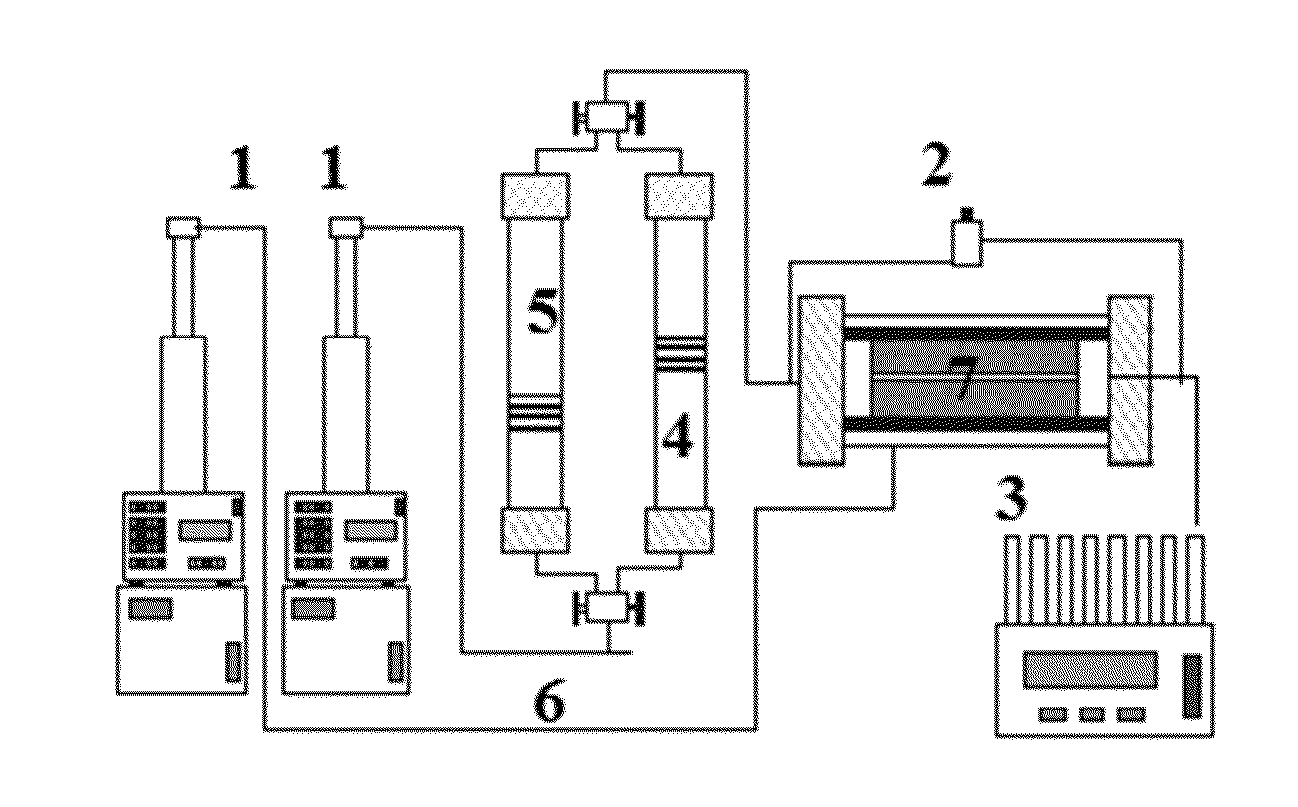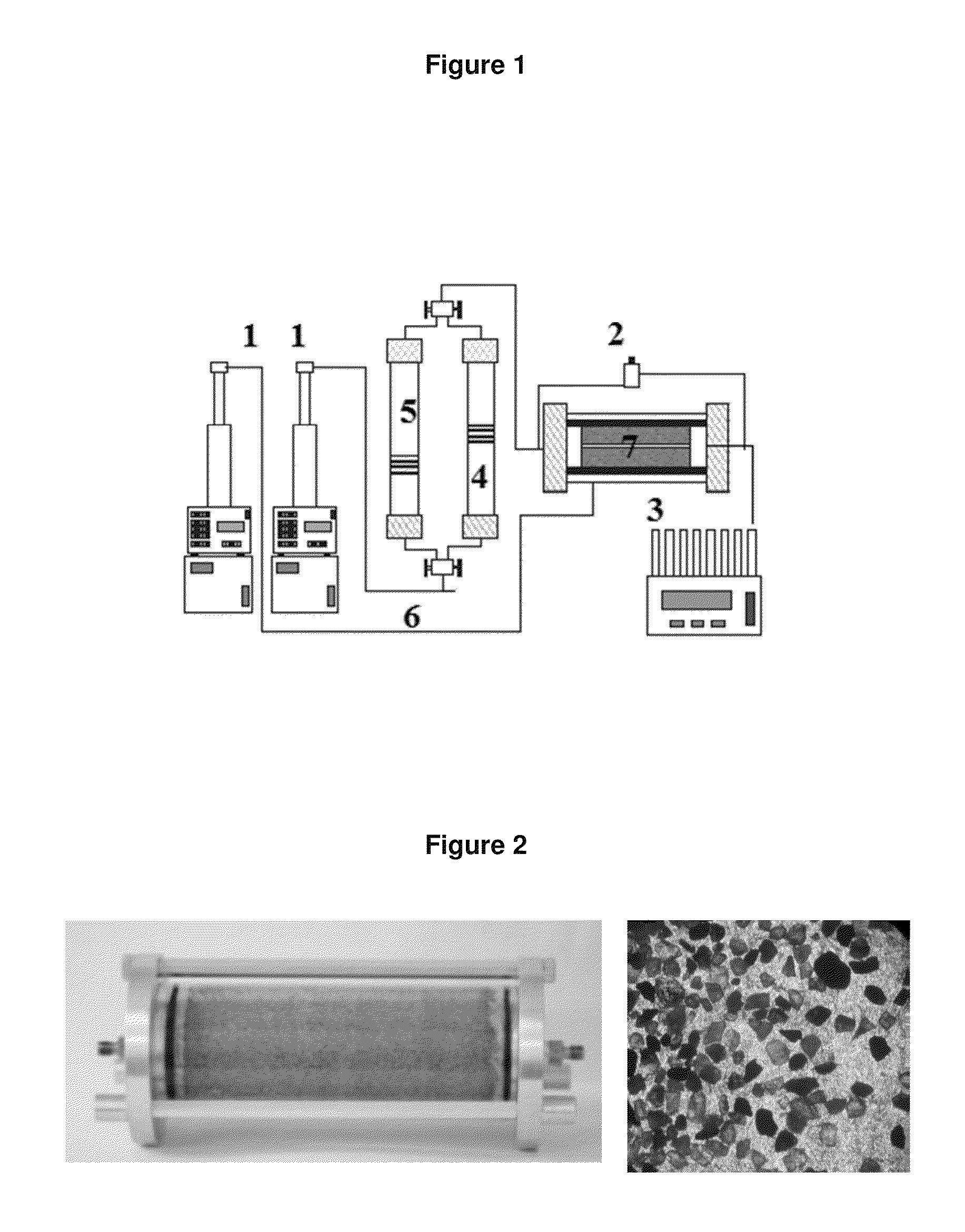Hydrophobic compound emulsions free of silicon and fluorine for an oil recovering method that modifies the wettability of rocks from hydrophilic to oleophilic
- Summary
- Abstract
- Description
- Claims
- Application Information
AI Technical Summary
Benefits of technology
Problems solved by technology
Method used
Image
Examples
example 1
Preparation of the Trioctylmethylammonium Octanoate Base Emulsion (Em 1)
[0037]In the first stage, the “concentrated” emulsion is prepared in a reactor that is coupled to the mechanical mixing system Ultra Turrax T25 Basic, by adding 1 g of Igepal CO 890 (emulsifier B) and 29 g of deionized water. The mixture is stirred until a transparent solution is formed. Afterwards, 70 g of trioctylmethylammonium octanoate (hydrophobic compound A), which has been synthesized previously, are added dropwise. The mixture is stirred at 16000 rpm for 15 min in order to form a visually homogeneous mixture. Igepal CO 890 is a polyoxyethylene (40) nonylphenyl ether having a number average molecular weight Mn of about 1,982 and an HLB of 17 from Sigma-Aldrich Co.
[0038]Afterwards, in the second stage, the preparation of the “ready-to-be-used” emulsion is carried out. In order to do so, in a glass reactor equipped with a stirring system, 1 g of “concentrated emulsion”, which was obtained in the first stage...
example 2
Oil Displacement Tests in Rock Cores
[0041]The examples concerning the oil recovery tests were carried out by using Berea rock cylindrical cores (7 in FIG. 1) with a diameter of 3.8 cm and a length of 8.2 cm. First, the cores are saturated with water and afterwards with Mexican “Maya” crude oil with 21° API gravity. Once the rock fragment is under the established oil saturation conditions, the oil recovery is carried out by injecting bidistilled water at a flux of 10 ml / h, as shown in FIG. 1, using injection pumps (1) and transfer cylinders (4 and 5). After injecting bidistilled water, 0.4 PV (pore volume) of chemical product (Em1) are injected at the injection inlet in order to continue with the injection of bidistilled water at a flux of 10 ml / h.
[0042]The oil volume recovered from the core (3 in FIG. 1) is measured and compared with the oil volume of the initial saturation of the rock core. The recovery efficiency is proportional to the displaced oil amount during the test in compa...
example 3
Oil Displacement Test in the Sand Packages
[0045]In order to evaluate the effect of the emulsions on the oil recovery in systems with higher permeability and pore volume, the decision of producing sand packages was made. For this oil recovery tests, packed-meshed-beach-sand cells with 13 cm in length and 4.5 cm in diameter were used. The sand features a nominal diameter below 250 μm, as shown in FIG. 2.
TABLE 3Data of the rock core tests.φVPKabsSoinRwaterRemulsionEmulsion(%)(ml)(MD)%ml%ml%mlT (h)Em121.520.4211.28417.158.910.0715.42.624Em221.821228.874.315.666.210.2522.63.520Em321.721246.680.516.957.59.722.53.820
[0046]Once the cell is under the established Maya oil saturation conditions (20.1° API, 544 mPa.s, 0.9317 g / mL at 20° C.; Oil 90 / Water 10), the oil recovery by injection of bidistilled water at a flux of 10 ml / h is performed. After water displacement, the corresponding emulsion at 0.1 PV was injected at the inlet in order to continue injecting water at a flux of 10 ml / h. Afterw...
PUM
 Login to View More
Login to View More Abstract
Description
Claims
Application Information
 Login to View More
Login to View More - R&D
- Intellectual Property
- Life Sciences
- Materials
- Tech Scout
- Unparalleled Data Quality
- Higher Quality Content
- 60% Fewer Hallucinations
Browse by: Latest US Patents, China's latest patents, Technical Efficacy Thesaurus, Application Domain, Technology Topic, Popular Technical Reports.
© 2025 PatSnap. All rights reserved.Legal|Privacy policy|Modern Slavery Act Transparency Statement|Sitemap|About US| Contact US: help@patsnap.com



